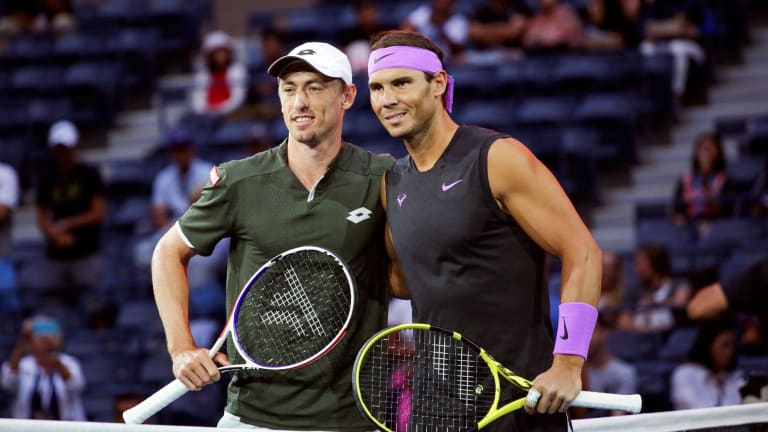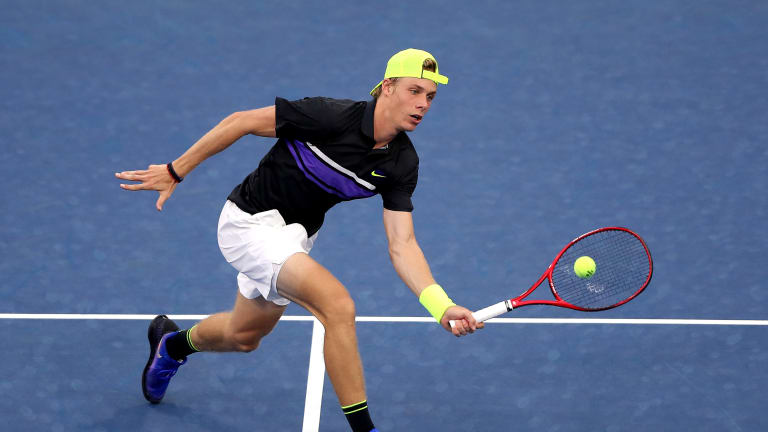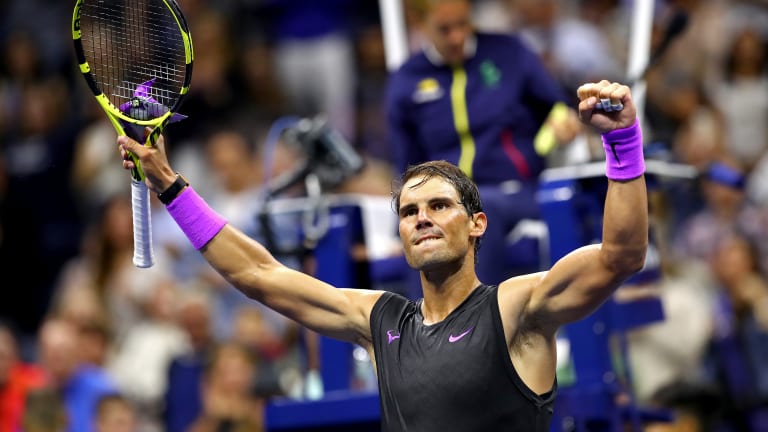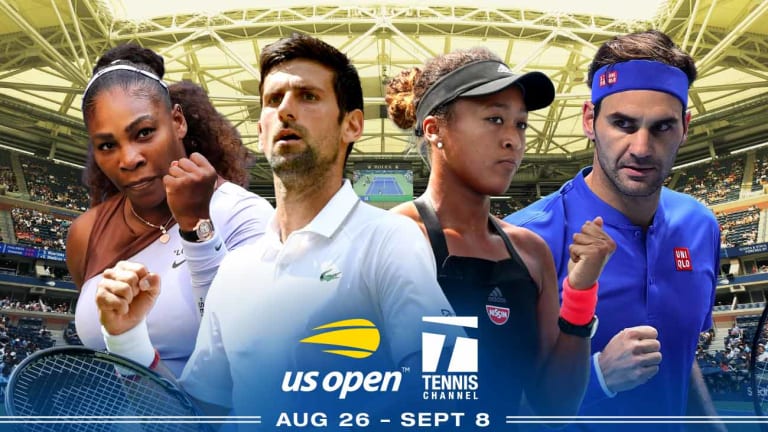A busy and entertaining evening on Ashe, Armstrong and Grandstand
By Joel Drucker Aug 28, 2019Eric Butorac will replace Stacey Allaster as US Open tournament director
By Associated Press Nov 17, 2025Beyond The Champions: 2025 US Open Winners and Losers
By Peter Bodo Sep 10, 2025In US Open defeat, Jannik Sinner faces his shortcomings
By Pete Bodo Sep 09, 2025Amanda Anisimova's US Open fortnight wasn't just "incredible"—it was redemptive
By Pete Bodo Sep 09, 2025Overcoming Doubt, Finding Deliverance: Six WTA takeaways from the 2025 US Open
By Joel Drucker Sep 08, 2025Service and a smile: How Carlos Alcaraz conquered Jannik Sinner at the 2025 US Open
By Steve Tignor Sep 08, 2025Carlos Alcaraz captures sixth Slam and second US Open title, dethrones No. 1 Jannik Sinner
By David Kane Sep 07, 2025Alcaraz vs. Sinner US Open final start delayed by 30 minutes
By TENNIS.com Sep 07, 2025Blinding Lights: Amanda Anisimova rues missed opportunities, serve woes after US Open final
By Stephanie Livaudais Sep 07, 2025A busy and entertaining evening on Ashe, Armstrong and Grandstand
World No. 2 Rafael Nadal faced John Millman and Denis Shapovalov took on fellow Canadian Felix Auger-Aliassime, while Aryna Sabalenka battled it out against countrywoman Victoria Azarenka Tuesday at the US Open.
Published Aug 28, 2019
Advertising
NEW YORK—The endings are what we recall, most of all the moments of triumph, elation, even redemption. But on this Tuesday evening, three first round US Open matches were simply a beginning. As six players sought to take small steps forward, they likely recalled the twists of fate that had come their way the last time they’d each competed in New York.
The nifty nighttime triangle promised past pain and potential hope. Arthur Ashe Stadium featured three-time US Open champion Rafael Nadal versus 60th-ranked John Millman. Nadal last year had been forced to withdraw mid-match from his semifinal versus Juan Martin del Potro with a knee injury. Millman was the Cinderella of the 2018 US Open. He reached the round of 16 of a major for the first time, at which point the diligent Australian took out Roger Federer before losing in the next round to eventual champion Novak Djokovic.

A busy and entertaining evening on Ashe, Armstrong and Grandstand
© AFP/Getty Images
Advertising
Getty Images
Just southwest of Ashe, two close friends, Canadians Denis Shapovalov and Felix Auger-Aliassime, returned to the same Grandstand court where a year ago a racing heart compelled Auger-Aliassime to retire from their first round match. A touching moment came at the net. Shapovalov consoled his compatriot, letting him know there were years of moments ahead for each. Little did Shapovalov know that in 2019, far more would come for his mate. Ranked 28 a year ago, Shapovalov is now 33. Meanwhile, Auger-Aliassime, 117 that night he left the Grandstand amid tears and anxiety, had soared to 19.
East of Ashe, inside Louis Armstrong Stadium, the Battle of Belarus, a first-time meeting between 21-year-old Aryna Sabalenka, seeded ninth here, and a player nine years her senior, former world number one Victoria Azarenka.
“It was important for both of us,” said Sabalenka. On this same court last year, Sabalenka had given Naomi Osaka her toughest test on the way to the title, a power barrage Osaka had squeaked out, 6-4 in the third. As for Azarenka, now ranked 41, her recent struggles since becoming a mother at the end of ’16 had summoned up a rewrite of “Sunrise, Sunset,” a song from the iconic musical, “Fiddler on the Roof” --
Where is the magic that was Vika?
Twice in the finals, she went three
I don’t recall my getting older
When, did she?
The transition from day to night at the US Open is at once sublime, crowded, noisy and enchanting, a hustle and bustle of tennis zealots chugging across, out and into the grounds for food and drink, matches and merchandise. Amid a humidity-free day, with temperatures in the high 60s, fans comfortably made their way to these three stadiums, each with its own array of sound and sight.

A busy and entertaining evening on Ashe, Armstrong and Grandstand
© Getty Images
Advertising
Getty Images
Seven minutes short of 6:30 p.m., the two Canadians commenced their US Open rematch. “I tried not to think about [last year] too much,” said Shapovalov.
Amid the late time of day and the half-filled stands, the Grandstand atmosphere was subdued. It began with the classic competitive combo platter: One sharp opponent – the lefty Shapovalov – pushing the other into error. Shapovalov often deployed a textbook southpaw pattern, slicing his serve wide in the ad court to open up a crisp up-the-line forehand. Auger-Aliassime was extremely passive, his shots committing the cardinal sin of rolling into the net. Swiftly went the first set to Shapovalov, 6-1. Once Auger-Aliassime failed to convert two break points in the opening game of the second set, the one-way traffic continued, Shapovalov winning the second by the same score to take a two sets to love lead in 56 minutes.
Much of what had made Shapovalov the US Open It Boy of 2017 – when he’d vaulted from the qualifying to the round of 16 – was in full stream, an angular barrage of lefty darts and arrows flung from both sides. Auger-Aliassime’s last possibility came when Shapovalov served at 2-3, 15-40 in the third. With the urgency he’d brought the entire match, Shapovalov won both points, held and then, at 4-all, earned the decisive break, closing out the final game at 15. “Pretty flawless” was the winner’s description of his effort, a victory aided by Shapovalov’s new coach, Mikhail Youzhny an accomplished, recently retired veteran and, Shapovalov stated with urgency, fellow owner of a one-handed backhand.
At the same time as Shapovalov prepared to serve that final game, another lefthander, Nadal, closed out the first set against Millman, 6-3. Short of Davis Cup, Ashe Stadium at night is as lively as a tennis crowd can get, a New York audience packed-in to witness greatness.
Of tennis’ Big Three, none is more physically imposing and possessed of competitive fervor than Nadal. Roger Federer dissects with scissor-like, clinical efficiency. Novak Djokovic smothers with footwork and proficiency. Nadal oppresses with willpower and raw, downright implicating effort. There is no way to prepare for him. Millman – no slouch in the tenacity department – was repeatedly on his heels, chasing, dashing, searching for answers to the harsh, lacerating questions Nadal kept asking. “I don’t have a different style of play,” said Nadal. “I play my style. Sometimes better, sometimes worst.”

A busy and entertaining evening on Ashe, Armstrong and Grandstand
© Getty Images
Advertising
Getty Images
So what if Nadal begins to return serve several feet behind the baseline. With extraordinary alacrity, he scampers forward and seizes control of the point. With Millman serving in the second set at 2-2, Nadal lashed a crosscourt forehand so deep and hard that the Aussie could only loft a backhand lob wide. On the next point, another massive Nadal forehand, this one down-the-line. An off-balance Millman poked a forehand into the net. Up now a set and a break, Nadal kept his foot on the accelerator – or Millman’s neck? – and soon took the second set, 6-2. Though he’d once seen such a lead vanish on this very court – versus Fabio Fognini in 2015 – that wasn’t going to happen this evening, Nadal rolling through the third, 6-2. “I’m happy that I was able to win tonight,” said Nadal. “It’s a good start. Let’s see.”
How each court differs: The circular layout and open-air surroundings of the Grandstand suggest the casual energy of a party held to support the arts. The massive dimensions of Arthur Ashe Stadium personify New York’s notion of itself as the Big Apple. Stroll into the two-year-old Louis Armstrong Stadium and you enter a tight rectangle, a cozy venue evocative of the world of boxing. Fitting indeed that Azarenka-Sabalenka offered many a slugfest-like rally. But this was never going to be a winning proposition for Azarenka. Though you’d hardly call her a light hitter, Azarenka’s game revolved around a synthesis of crisp strikes and superb movement that, akin to Djokovic, over time elicited a noose-tightening-like capitulation.
All seemed on course for Azarenka in an excellent first set that she captured 6-3. Sabalenka pouted. Azarenka pumped. And when Azarenka broke Sabalenka and served in the second set at 2-0, the elder appeared on-course for the kind of redemptive win that has long eluded her since becoming a mother at the end of 2016. Sabalenka’s description of that stage: “I was going crazy and crazy.” There were screams to her posse, most of all to the person she trusts most with her tennis game, former pro Dmitry Tursunov. Sabalenka also thought that at this point of the match, she needed to “make it interesting” for Azarenka. While for most players, that usually translates into consistency and less power, with Sabalenka the message differs: damn the torpedoes, hit harder.
Serving at 2-0, 30-love, Azarenka netted a makeable forehand. Ditto at 30-all. Skilled as Azarenka is, when pressed, she lacks the safe topspin on that flank a player like Nadal relies on. Holding a point for 3-0, Azarenka was pushed hard enough by a Sabalenka to spray a forehand long. Another forehand error handed Sabalenka the break – and, on the emotional front, the best possible lifeline for keeping in this match, even as Sabalenka continued to intermittently sulk and emote to her team. If not quite the sustained mover Azarenka is, Sabalenka has moments of inspired sprinting, prominently so when she took the second set with an electrifying forehand winner.

A busy and entertaining evening on Ashe, Armstrong and Grandstand
© Getty Images
Advertising
Getty Images
This really was a heavyweight battle, lacking only the cigarette and cigar smoke that had once pervaded such New York venues as Madison Square Garden. Of the night’s three matches, this by far had the most intensity, Armstrong also alive with the energy of those staking seats in advance of the match after between Nick Kyrgios and Steve Johnson.
Though Azarenka served at 2-1 in the third, it was hard to believe this lead would hold up. Sabalenka complied to level the match.
And then, as can happen in a fight, one competitor took charge with a vengeance. Sabalenka served at 4-all, struck two forehand winners and an ace to hold at love. She quickly went up 15-40 on Azarenka’s serve and then struck the ball just forcefully to elicit yet another Azarenka forehand miscue. It had lasted two hours and 13 minutes – but all come down to Sabalenka taking eight of the last nine points.
For three, an ending. Auger-Aliassime has yet to win a US Open main draw match, but as a teenager, still has plenty of time. Millman will see last year’s quarterfinal points vanish and continue to grind as only an Aussie can. As for Azarenka, runner-up here back in ’12 and ’13, one wonders how she will assess yet another frustrating loss.
For three others, life beyond the beginning. Shapovalov, this year quite enigmatic, tonight showed what can make him a big match player. The 33-year-old Nadal once again brought to life a pet quote from the woman for whom this tennis center is named, Billie Jean King: persistence is a talent, Nadal tennis’ Sisyphus in his relentless ability to return from injury.
“I have the same body,” said Nadal. “Well, I would love a new body, but not possible for the moment. Maybe in 100 years you will be able to change things, but not now.”
And Sabalenka demonstrated that it’s possible to pout, sulk, and power your way to victory. Fifteen minutes short of midnight, Sabalenka said, “I’m happy I found something at the important moments.”
All three also knew that happiness was transitory, this evening’s triumphs a fleeting occasion – but at least one that would keep them alive at the decade’s final major.

A busy and entertaining evening on Ashe, Armstrong and Grandstand
Advertising
Wake up every morning with Tennis Channel Live at the US Open, starting at 8 a.m. ET. For three hours leading up to the start of play, Tennis Channel's team will break down upcoming matches, review tournament storylines and focus on everything Flushing Meadows.
Tennis Channel's encore, all-night match coverage will begin every evening at 11 p.m. ET, with the exception of earlier starts on Saturday and Sunday of championship weekend.